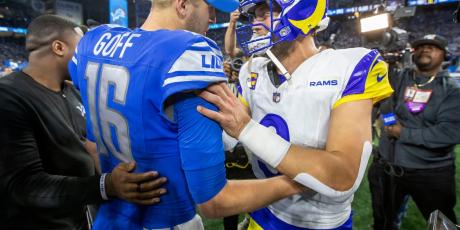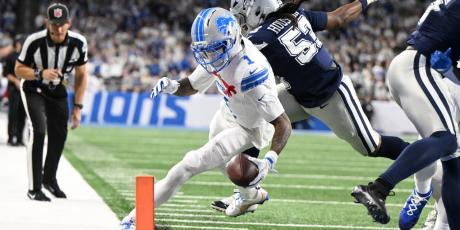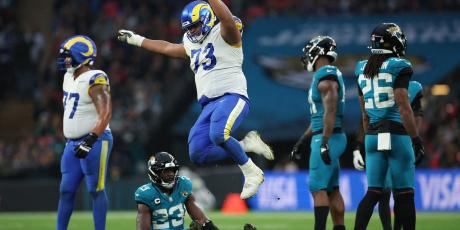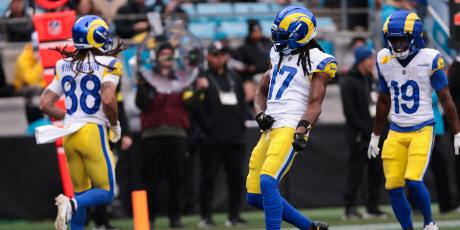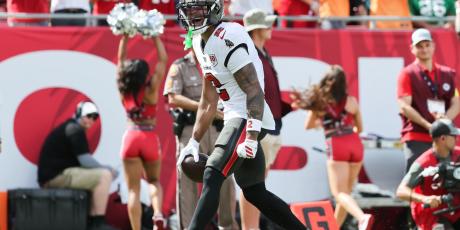Understanding NFL Next Gen Stats in 2024
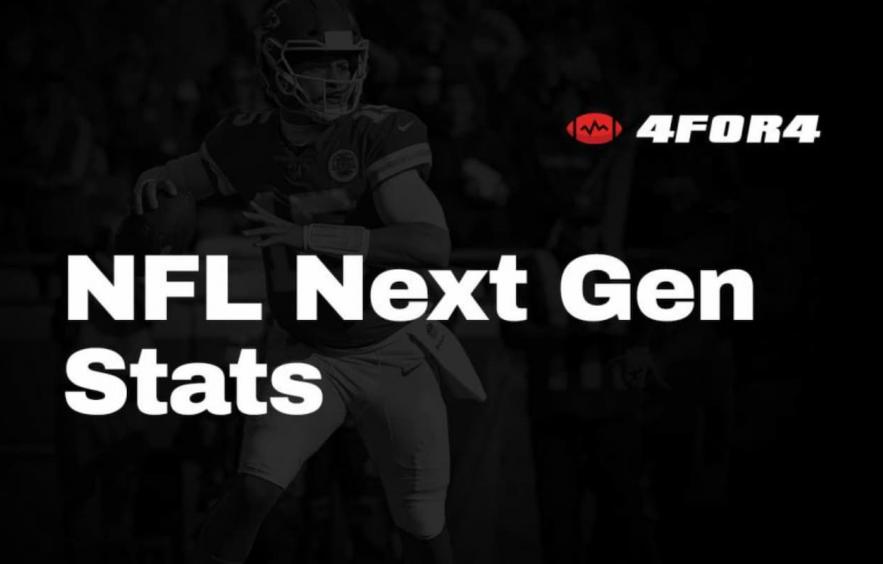
If you’ve watched enough football over the past few years, you’ve likely noticed the growing presence of Next Gen Stats in NFL broadcasts. Whether through TNF’s Prime Vision, the popular “Catch Probability” highlights, or new and mysterious stats like “pressure rate” and “air yards,” the NFL’s unique player-tracking engine has created a whole new pocket of data for fantasy nerds to mine.
But what are the relevant Next Gen stats, and when and how can we use them to further our fantasy acumen? This article should give you a solid starting point for both questions. And if you have any others, reach out on X (@MattOkada)!
Note: You can find a full Next Gen Stats glossary here.
Next Gen Passing Stats
Air Yards
At the core of much of what Next Gen Stats does with the passing game is “Air Yards,” or “the vertical yards on a pass attempt at the moment the ball arrives at its target, in relation to the line of scrimmage.” You may have heard it labeled “depth of target” and more common terminology might describe how far “downfield” a pass traveled. By any name, they’re a metric to separate deep shots from dump-offs, and everything in between.
“Intended air yards” (air yards on pass attempts) and “completed air yards” (air yards on completions) both correlate well with fantasy points, as QBs who are successfully driving the ball downfield are going to score more fantasy points on average than those who lean on the dink-and-dunk. As an example, last season, Patrick Mahomes averaged a career-low 0.47 fantasy points per attempt, totaling 280 points on the season and finishing as the QB8. The Next Gen Stats data shows that his average intended air yards (6.6) and average completed air yards (4.0) were both career lows as well … by a lot.
| Season | Average Air Yards (Intended / Completed) | Fantasy Points Per Attempt |
|---|---|---|
| 2023 | 6.6 / 4.0 | 0.47 |
| 2022 | 7.5 / 5.4 | 0.64 |
| 2021 | 7.3 / 4.8 | 0.55 |
| 2020 | 8.5 / 6.3 | 0.64 |
| 2019 | 8.6 / 6.2 | 0.59 |
| 2018 | 9.2 / 6.4 | 0.72 |
As the table shows, Mahomes’ fantasy points have correlated very closely with his average air yards throughout his career — and this principle translates pretty smoothly to all QBs on the whole.
Over the last five seasons, the 34 QBs to average 9+ intended air yards in a season scored 0.12 more fantasy points per attempt than the 30 QBs below 7 intended air yards. Over 500 attempts in a season, that’s a drop of 60 fantasy points, roughly the difference between last year’s QB7 Jared Goff and QB19 Geno Smith.
Quarterbacks with lower air yards benchmarks can still be viable for fantasy — Drew Brees and Cam Newton are good examples from vastly different archetypes. But as a rule, pushing the ball downfield typically correlates well with more efficient fantasy production and provides us with upside plays like C.J. Stroud and Josh Allen.
Completion Percentage Above Expectation
One of the more popular examples of Next Gen Stats I mentioned early in the introduction was “Completion Probability” — you may have seen it flashed on NFL Network highlights of particularly wild touchdown passes, like this one from Russell Wilson to Courtland Sutton last season.
Courtland Sutton TOE DRAG TOUCHDOWN.
📺: #DENvsBUF on ESPN/ABC
📱: Stream on #NFLPlus https://t.co/J3bHxYOoK2 pic.twitter.com/92QDtbHv70— NFL (@NFL) November 14, 2023
Russell Wilson's 7-yard touchdown pass to Courtland Sutton had a completion probability of 3.2%, the most improbable completion of the Next Gen Stats era.
🔹 Scramble Distance: 16.3 yds
🔹 Air Distance: 37.8 yds
🔹 Sideline Distance: -0.7 ydsPowered by @awscloud pic.twitter.com/1rO4I6h7aR
— Next Gen Stats (@NextGenStats) November 14, 2023
From the data NGS has collected on these factors, they produce an “Expected Completion Percentage” statistic (xCOMP), which can then be used to calculate a QB’s “Completion Percentage Above Expectation.” A passer’s xCOMP is a good indicator of how often they’re making “tough throws” rather than easy ones, and a passer’s completion percentage above expectation is often a good indicator of their accuracy and efficiency on all throws.
| Player | % Over Expected | Player | % Below Expected |
|---|---|---|---|
| Kirk Cousins | +4.4 | Baker Mayfield | -2.8 |
| Joe Burrow | +3.6 | Carson Wentz | -2.7 |
| Geno Smith | +3.5 | Trevor Lawrence | -2.2 |
| Dak Prescott | +3.1 | Ben Roethlisberger | -2.1 |
As a rule, the best in the “above expectation” business are known for succeeding on the chances they take, while taking fewer of those chances. The lowest outputs mostly belong to guys willing to sling it without the greatest results, or in some cases to dink-and-dunkers with such a high xCOMP that their actual completion percentage ends up being lower by necessity.
Most of the time, the best fantasy passers are those with a positive differential above an average or slightly above average xCOMP. This is because quarterbacks with extremely high xCOMPs — like Jimmy Garoppolo or Alex Smith — often end up being consistent but low-upside “game managers,” while QBs with extremely low xCOMPs — most famously Jameis Winston — are usually volatile as passers, with high highs and low lows.
There’s a lot of room for fantasy production through different iterations of these statistics, but it’s helpful to know what they mean for a player’s consistency, upside, and all-around fantasy production.
Time to Throw
Time to Throw is quite simply how many seconds a quarterback takes from snap to throw on each dropback. It can often be as much an indicator of offensive scheme and protection as it is of a QB’s processing speed or willingness to scramble, but it typically involves some combination of all three. In Trevor Lawrence’s dismal rookie season under Urban Meyer and Darrell Bevell, he had a 2.87-second time to throw, which was above league average (around 2.8). In the next two years, while maturing under Doug Pederson and Press Taylor, his TT plummeted to 2.59 and then 2.51.
Time to throw doesn’t have the strongest correlation to fantasy points, largely because of how much scrambling QBs tip the scales, but it can offer some insights when combined with additional context. If a passer has a low time to throw and high intended air yards, they’re like a volatile pocket-passer with big upside and a few extra interceptions (Ryan Fitzpatrick). If they have a high time to throw and low intended air yards, they’re probably young, inexperienced, and at risk of inflated sack rates (Tommy DeVito). Typically, lower times to throw are better for QB production if you’re not racking up points on the ground (guys like Tom Brady and Tua Tagovailoa win this way). But every once in a while, there’s a C.J. Stroud exception that combines high time to throw with high intended air yards and finds impressive week-to-week production through big play efficiency.
Next Gen Rushing Stats
Efficiency
Next Gen Stats’ rushing efficiency metric (EFF) is calculated by measuring the total distance a player travels (in any direction) per rushing yard gained (downfield). At its core, it is a measurement of how “North/South” a runner tends to be. While the number doesn’t correlate that strongly with fantasy points, it does have a strong inverse correlation with yards per carry averages — that is, as the efficiency number gets lower (for more North/South runners), the yards per carry goes up.
This correlation is swayed by more volatile “big-play” runners, as you will commonly see more breakaway runs from the lower EFF metric guys. Guys like Jonathan Taylor, De'Von Achane, Rashaad Penny, and Ronald Jones typically put up very low EFF numbers, and are known for getting downfield in a hurry and for breaking off big gains. Players like Todd Gurley, Le'Veon Bell, and Dameon Pierce post much higher EFF numbers and are known for dancing behind the line and sometimes making a lot out of a little.
As with time to throw, fantasy backs can win in different ways with different EFF markers. Pass-catching studs like Austin Ekeler and Giovani Bernard often post productive fantasy seasons with high EFFs, but more “pure rushers” like Taylor and J.K. Dobbins (when healthy) have had extremely efficient fantasy stretches with extremely low EFFs.
Rush Yards Over Expected
Similar to “Completion Percentage Over Expected,” Next Gen Stats also has a metric to measure expected rushing yards on a given play and then calculate the rush yards over expected (RYOE). Unsurprisingly, this number also correlates very closely with yards per carry, but can provide a little more insight to that number, with a little less dilution from broken plays.
Guys like J.K. Dobbins and Rashaad Penny are still high on the RYOE list, but we can also see the rise of interesting names like Jahmyr Gibbs (+2.01 average RYOE) and Tyjae Spears (+1.62), who have flashed the skills to make more out of a rush than the average player. We can also identify RBs who will likely never hold down a job as a team’s primary runner, such as Tevin Coleman (-0.91 in our five-year sample), Tyler Allgeier (-0.72), and Cam Akers (-0.51). Players with aspirations of efficient fantasy seasons despite low RYOEs will likely need to find value in the passing game (Giovani Bernard, Leonard Fournette, Austin Ekeler) or the touchdown department (James Conner, Jamaal Williams).
Next Gen Receiving Stats
Average Targeted Air Yards
Maybe outside of one or two quarterback stats, Next Gen’s most recognizable impact in the fantasy community belongs to air yards for receivers. Since we’ve covered the definition of air yards in the passing section above, we can focus here on how it translates to pass-catchers.
First, average targeted air yards (TAY), known colloquially to some as average depth of target (aDOT), is exactly what it sounds like — the average number of air yards downfield that a receiver sees on each target. It’s not at all difficult to pinpoint guys like Marquez Valdes-Scantling and Gabe Davis for high TAYs. These are your downfield specialists, who will typically be more volatile for fantasy but often responsible for boom weeks throughout a season. On the flip side, you have your Deebo Samuels, Rondale Moores, and typical tight ends, who more commonly see passes closer to the line of scrimmage and are then asked to create after the catch.
As with several of the metrics we’ve discussed, you can get excellent fantasy production from both ends of the spectrum on TAY. A perfect example can be found with the 2023 49ers. Last season, Deebo Samuel posted 2.40 fantasy points per target (one of the highest in our entire sample) with an extremely low average TAY of 6.8 … while his teammate Brandon Aiyuk logged an also-impressive 2.02 points per target sporting an extremely high average TAY of 14.1. The league average is right around 10 air yards per target, so they were very nearly bookend outliers on either side, but both were extremely efficient.
Once again, context can be key for translating this metric into actionable analysis. Is a receiver a yards-after-catch superstar? His low TAY is probably not an issue. Is a deep-ball specialist with a high yearly TAY switching from a gunslinging QB to a rookie game manager this year? That might be a bad sign for his fantasy outlook.
It’s also worth noting that TAY can be very specifically applied based on your draft or league format. If you’re playing in a PPR league with a tight-end premium (extra points for TE receptions), Evan Engram and his low TAY (and therefore higher catch rate) gets a pretty significant boost. Are you drafting a best-ball team to win a massive cash prize? Well, those “better-in-best-ball” wideouts are very commonly identified by high TAYs — guys like Rashid Shaheed and Calvin Ridley were inconsistent last year but had several big weeks perfectly suited for best ball.
% Share of Team’s Air Yards
While targeted air yards are valuable, higher numbers don’t necessarily mean “stud” receivers, just specific kinds of receivers. If you’re looking to find the true studs, that’s where share of team’s air yards (TAY%) comes into play. This metric takes a player’s targeted air yards and calculates it as a chunk of their team’s total air yards, creating a measurement of who’s earning the highest volume of their team’s most valuable targets. The top of this metric typically looks like a who’s who of wide receivers and tight ends, with names like Justin Jefferson, Davante Adams, and Mark Andrews consistently leading their positions.
This metric is also extremely valuable in identifying breakout candidates, as a player with a high TAY% going from a bad situation to a better one will typically see noteworthy improvement. The highest single-season TAY% in our five-year sample belonged to D.J. Moore in 2022 (with the Panthers), when he saw 118 questionable targets from Baker Mayfield, Sam Darnold, and P.J. Walker. While 118 targets is low for a team’s WR1, and 888 receiving yards is less than encouraging, Moore’s 48.7% share of Carolina’s air yards suggested he was a dominant alpha who could be huge for fantasy with the right opportunity. The next year, Moore went to Chicago and — with just a slight bump in target quality (to Justin Fields) and total targets (to 136) — scored 238.5 fantasy points to finish as the WR6 on the season.
Obviously, all TAY% are not created equal, as a 35% share of the Chiefs’ air yards is going to be worth far more than 35% of the Patriots’ air yards so that context is important to keep in mind. But if you’re looking to identify “X receivers,” or those rare “top-target tight ends,” this is a good way to do it. As a 2024 example, Garrett Wilson posted a 44.8% share of the Jets’ air yards last season but finished as just the WR32 thanks to the dismal quality of the targets and the low passing volume overall. But should those roadblocks shift dramatically with Aaron Rodgers back under center, Wilson has the ability (highlighted but that TAY%) to skyrocket into the elite WR1 stratosphere.
The Bottom Line
- Next Gen Stats are best used to learn and understand the game, evaluate player talent, and explain the trends we see on the field. They’re not often the most predictive in a vacuum but can help us spot useful nuggets of data when properly contextualized.
- In most cases, the NGS metrics are most effective at telling us what kind of player someone is, rather than whether they’re going to be a fantasy stud or not. It’s up to you (or your favorite fantasy analyst) to fit those metrics into a bigger picture and project the relevant consequences.
- Several of the stats we discussed here are most relevant in identifying volatility versus consistency in a player’s production, so use those numbers in conjunction with a good understanding of your fantasy drafts/leagues to find advantages.
- While these and other “rate” metrics are useful, volume is still king in fantasy. Ideally, our QBs would have high average completed air yards and our RBs would have low NGS Efficiency marks, but those numbers aren’t converted into fantasy points without opportunity.


